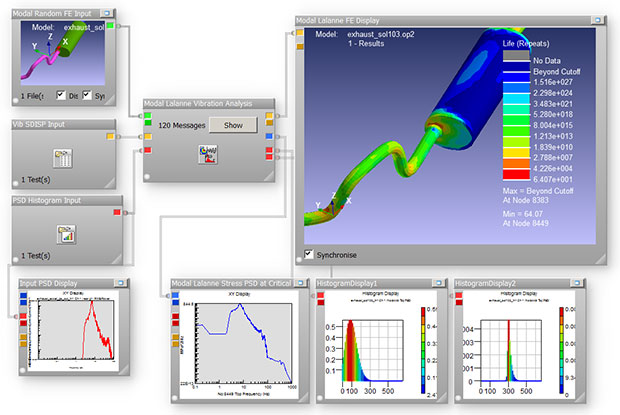Editor’s Pick: Durability and Fatigue Analysis Suite Enhanced

In version 11.0, the nCode DesignLife vibration fatigue solver sees such improvements as new types of loading, conditions, calculations and additional methods, including Sine on Random. Image courtesy of HBM nCode.
Latest News
April 29, 2015
Dear Desktop Engineering Reader:

Summer is coming, so you’re about to be subjected to a few hundred renditions of “Good Vibrations.” Everything has its natural frequency, and this song has been played with much frequency since its fall 1966 debut, airing approximately twice per hour daily through fall 2014.
Vibration and frequency must be accounted for during durability analyses or, for example, parts fly off your engine. The trick to preventing operational failures and avoiding overdesign is how you handle analyzing huge sets of measured vibration and frequency data. With that thought, here’s some interesting news from HBM nCode that came in over the newswire recently.
The short of it is that version 11.0 of the company’s nCode suite of durability, test and analysis software is out. The suite has three main applications: GlyphWorks for graphical data processing, nCode DesignLife for fatigue analysis applications and nCode Automation for managing data and automating analysis.
Version 11.0 focuses on new and enhanced capabilities for designing and validating components subjected to vibration excitation. DesignLife, which handles high to low cycles, crack initiation, crack growth and so on, sees improvements to its plasticity model and its automatic analysis selection methods.
Vibration fatigue analysis gets a boost from some additional methods including multiple simultaneous PSDs (power spectral densities) and Sine Dwell loading. These should be of interest to users running engine and powertrain applications. For virtually generating loads to calculate input loads, you have a Strain Gauge Analysis engine in DesignLife. For your load reconstruction processes, what it does is identify good locations for strain gauges and helps you select the right amount of gauges to use.
 This nCode DesignLife image depicts the dynamic loading of an exhaust system by an acceleration profile. Here, DesignLife 11.0 uses the frequency response results from a finite element solution and the PSD (power spectral density) of loading to calculate the PSD of stress at every location in the finite element model. Image courtesy of HBM nCode.
This nCode DesignLife image depicts the dynamic loading of an exhaust system by an acceleration profile. Here, DesignLife 11.0 uses the frequency response results from a finite element solution and the PSD (power spectral density) of loading to calculate the PSD of stress at every location in the finite element model. Image courtesy of HBM nCode.Frequency analyses now have new pre-defined processes for auto-correlation and cross-correlation of input data with various lags/scaling options. Other new features include a waterfall analysis method and the ability to generate Campbell plots.
You can learn more about nCode version 11.0 from today’s Pick of the Week write-up and at the far side of the links provided. HBM nCode also hosted a webinar on what’s new in nCode 11.0 earlier today. My contact tells me that it should be available on-demand today, so you’ll find a link to that webinar at the end of today’s Pick of the Week write-up. I get good vibrations from the people at HBM nCode. Check out nCode 11.0 to get some excitation too.
Thanks, Pal. – Lockwood
Anthony J. Lockwood
Editor at Large, Desktop Engineering
Subscribe to our FREE magazine, FREE email newsletters or both!
Latest News
About the Author
Anthony J. Lockwood is Digital Engineering’s founding editor. He is now retired. Contact him via [email protected].
Follow DE






